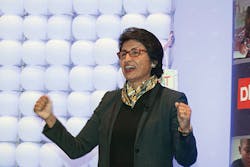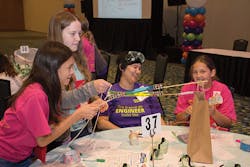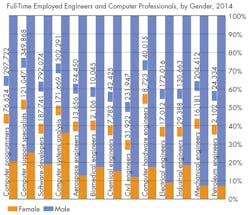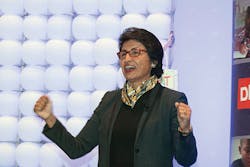This file type includes high-resolution graphics and schematics when applicable.
As the demand for more engineers in the workforce intensifies—the U.S. Department of Labor expects jobs in engineering to grow by 8% between 2012-2022—the need to thoughtfully groom our future engineers becomes stronger than ever. Part of that increase in jobs means putting efforts into closing the present gender gap in STEM, empowering capable future women engineers to discover their talent and find their place within the STEM pipeline.
Women remain widely under-represented in most STEM professions. While women make up over 57% of college graduates, only 14.8% of engineers in the workforce are women.1 The gender gap in professional STEM fields varies by specialty, but it remains relatively wide across the board. For example, only (approximately) 7% of mechanical engineers, 12% of civil engineers, 15% of chemical engineers, and 13% of aerospace engineers are women.2
However, progress has been made toward equalizing the gender imbalance between men and women in STEM fields. Over the last 10 years, interest in majoring in engineering, math, statistics, and computer science has increased among both males and females. We are seeing the most progress in computer-engineering disciplines, with women making up approximately 36% of computer systems analysts, and 26% of computer support specialists.3 However, overall, males are far more interested in pursuing a degree in STEM fields, with almost 27% of male freshmen indicating an intention to major in engineering, math, statistics, or computer science compared to only 8% of female freshmen in 2014.4
We must remain a figure of support and resource to professional and collegiate women in technical careers in order to increase the number of women in STEM. But, a shift in focus is necessary to implement dual efforts into targeting girls at the K-12 level to be an impactful influence for change.
Breaking the Barriers as a Young Girl Interested in STEM
One of the ways to close the gender gap is to take efforts all the way down to the K-12 level. It has been demonstrated that the K-12 stage in life is significantly important for career motivation. K-12 is the timespan where girls first get exposed and take an interest in STEM. However, despite performing at similar levels as their male counterparts, girls’ confidence and interest in engineering and math experiences a decline during middle school.
The decline can be attributed to a variety of events. Often, girls have a lack of exposure to STEM-related activities outside of school. These types of activities include computer programming, gaming, engineering (building) things, etc. Boys are naturally exposed to these things, while girls are usually more exposed more to things like dolls, cooking playsets, and dress up. Unconscious bias plays into this—parents and influencers do not necessarily know that their children are being exposed so differently and sometimes it just happens naturally.
The unconscious bias plays inside and outside of school, all the way up to the collegiate and professional level. Many people do not see STEM opportunities as a viable opportunity for girls. Therefore, girls who express an interest in STEM early on often lack encouragement to pursue these fields, while their male counterparts receive full support from teachers, parents, and other influencers.
Finally, many girls, minorities, and even boys may experience a general a lack of resources in school and their community. Many public school districts are cutting programs, and often times, STEM-related programs are the first to go. Moreover, many communities do not even offer these programs in the first place. Federal support of STEM education is moving the needle, but we still have a way to go.
The Importance of Influence and Mentorship
Parents, guardians, and teachers—all adult influencers—usually take on an important mentorship role when it comes to STEM influence, engineers by trade or not. Adult influencers do not have to be engineers or technologists to make an impact. In fact, the top influences on choosing to pursue science and engineering have been found to be your parents and your K-12 teachers.5
Parents, teachers, and guardians will play the most important role in helping young girls overcome the unconscious bias and lack of support for girls in STEM. If there is potential, it is up to these influencers to turn it into something successful. Most women engineers you talk to will say they became an engineer because a parent or teacher saw something in them, told them what an engineer does, and encouraged them to eventually become one.
Outside influencers are just as important, though. Women engineers have an opportunity to play a big role in encouraging our young, future engineers. You cannot be what you cannot see, making women engineers so important in driving change.
Women in Modern Engineering
Women in engineering are still facing adversity in the workplace. Many STEM industries remain generally male-dominated and, therefore, isolating to women occupying positions at these organizations. Many Society of Women Engineers (SWE) members can tell stories about receiving surprised looks from their male colleagues when they step out into the field, or take control of a meeting in the office.
The adversity can be attributed to unconscious bias—many do not even realize they are doing it. Some simply do not view engineering as a sustainable career option for a woman. That view trickles down to the K-12 level, so we must dispel these myths, prove ourselves, and influence our younger female counterparts.
Showing young girls what an engineer looks like is one of the most significant impacts a woman engineer can make. Talking to young girls and showing them that women are just as capable as men will change the misguided perception of an actual engineer.
One of the ways that our SWE members accomplish this goal is by participating in outreach activities in their local areas. For example, you can talk to the science teachers at your local schools to organize informal presentations so that students can learn more about what you do as an engineer. You can arm them with resources to learn more about engineering; therefore, when you step outside the classroom, it will extend your influence.
Getting in front of students will give you the opportunity to tell them about groups like National Center for Women & Information Technology’s “Aspirations in Computing," a high school program you can join online, connecting you with role models and other peers. The program connects girls with young women already studying computer science and doing things like creating their own apps.
Girls Who Code is another great program where young girls interested in computer science can get information, support, and hands-on experience. Being part of networks like this is very powerful, and from here, girls can discover more activities happening locally that will foster their interest in STEM.
Organizations like SWE are helpful, too. Our members will talk to young girls about the resources we offer, including SWENext, a program for girls under 18 that provides resources to help them on their path to pursuing engineering—scholarship opportunities, engineering camps and competitions, webinars featuring engineers from different disciplines talking about a day in their life, mentors, and other resources for families and educators that can help promote a career in engineering to young girls.
Another way to influence young girls in your area is hosting events and showing girls what engineering is all about. You can host these in conjunction with schools, local camps, or your company. Visit Design Squad’s website to find simple activities you can do with girls to show them the fascinating world of engineering.
Many professional women engineers attribute where they are today to role models and mentors—sometimes parents, sometimes teachers, and many times other women engineers. Showing young girls what a women engineer looks like will give young girls the confidence to go out and be that engineer themselves.
Karen Horting is the Executive Director & CEO for the Society of Women Engineers (SWE), overseeing the non-profit organization’s global initiatives in support of women in engineering and technology.
References:
1. National Science Foundation, 2013.
2. U.S. Census Bureau, 2014 Community Survey 1-year Estimates: Tables B24125 and B24126. Data retrieved from www.factfinder.census.gov.
3. U.S. Census Bureau, 2014 Community Survey 1-year Estimates: Tables B24125 and B24126. Data retrieved from www.factfinder.census.gov.
4. National Science Board. Science and Engineering Indicators 2016. Arlington, Va.: National Science Foundation (NSB-2016-1).






